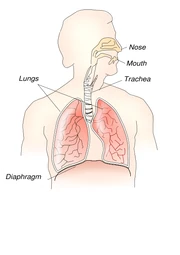
The Respiratory System is the group of organs responsible for carrying oxygen from the environment to the bloodstream and for expelling carbon dioxide. [1] Its primary function is to supply the blood with oxygen in order for the blood to deliver oxygen to all parts of the body. This occurs through breathing. The respiratory system is comprised of the airways, lungs, and the respiratory muscles.
Breathing[]
Respiration is breathing, i.e. inhaling and exhaling. More specifically, it is the exchange of gases between the external environment and an organism's cells. [2][1]
Respiration is achieved through the mouth, nose, trachea, lungs, and diaphragm.[3] Inhalation is initiated by the diaphragm[4] and supported by external intercostal muscles; oxygen enters the respiratory system through the mouth and the nose.
The oxygen then passes through the larynx (where speech sounds are produced) and the trachea, which is a tube that enters the chest cavity. In the chest cavity, the trachea splits into two smaller tubes called the bronchi. Each bronchus then divides again to form the bronchial tubes. The bronchial tubes lead directly into the lungs where they divide into many smaller tubes which connect to tiny sacs called alveoli. The average adult's lungs contain about 600 million of these spongy, air-filled sacs that are surrounded by capillaries.
The inhaled oxygen passes into the alveoli and then diffuses through the capillaries into the arterial blood. Waste-rich blood from the veins releases carbon dioxide into the alveoli. The carbon dioxide follows the same path out of the lungs during exhalation.[5]
Lungs[]

1:Trachea 2:Pulmonary artery 3:Pulmonary vein 4:Alveolar duct 5:Alveoli 6:Cardiac notch 7:Bronchioles 8:Tertiary bronchi 9:Secondary bronchi 10:Primary bronchi 11:Larynx
The lungs are the primary organs of the respiratory system.[6] The two lungs are located in the chest on either side of the heart. Their principal function is to transport oxygen from the atmosphere into the bloodstream, and to release carbon dioxide from the bloodstream into the atmosphere. They also help in regulating the concentration of hydrogen ion (pH) in your blood.[7] This exchange of gases is accomplished in the network of specialized cells that form millions of tiny, exceptionally thin-walled air sacs called alveoli.[8] The lungs are made of spongy, elastic tissue that stretches and constricts during respiration. The airways that bring air into the lungs (the trachea and bronchi) are made of smooth muscle and cartilage, allowing the airways to constrict and expand.[7]
Trachea[]
The trachea, or "windpipe", is the tube that extends from the larynx to the bronchi, which serves as the principal passageway for air to and from the lungs.[6] The trachea begins immediately below the larynx (voicebox), runs down the center of the front part of the neck and ends behind the upper part of the sternum. Here it divides to form two branches which enter the lung cavities.[9]
Bronchi[]
A bronchus (plural bronchi, adjective bronchial) is one of two large tubes at the bottom of the trachea.[10] The left bronchus leads to the left lung and the right bronchus leads to the right lung. Each bronchus—the name for just one bronchi—branches into smaller and smaller bronchial tubes. No gas exchange takes place in this part of the lungs.[11] Bronchioles are the tiniest bronchial tubes. Each lung has about 30,000 bronchioles that are about the same thickness as a hair.[10]
Diaphragm[]
The diaphragm is the musculomembranous partition separating the abdominal and thoracic cavities which serves as the primary muscle aiding inhalation. [2][1] The diaphragm's function is to help pump the carbon dioxide out of the lungs and pull the oxygen into the lungs. As the diaphragm contracts and relaxes, breathing takes place. When the diaphragm contracts, oxygen is pulled into the lungs. When the diaphragm relaxes, carbon dioxide is pumped out of the lungs. Exhalation is primarily a passive process, but during forced or active exhalation, as when blowing out a candle, expiratory muscles including the abdominal muscles and internal intercostal muscles, generate abdominal and thoracic pressure, which forces air out of the lungs.[5] The diaphragm is also involved in non-respiratory functions: helping to expel vomit, feces, and urine from the body by increasing intra-abdominal pressure, and preventing acid reflux by exerting pressure on the esophagus as it passes through the esophageal hiatus.[12]
See Also[]
References[]
- ↑ 1.0 1.1 1.2 unk. (n.d.). Respiratory Disorders Glossary. LPCH.org. Retrieved on 2008-10-01.
- ↑ 2.0 2.1 McGraw-Hill Concise Dictionary of Modern Medicine (2002). Respiration. McGraw-Hill. Retrieved on 2008-10-01. Cite error: Invalid
<ref>tag; name "Med" defined multiple times with different content - ↑ Franklin Institute (n.d.). Respiratory System: Oxygen Delivery System. The Franklin Institute. Retrieved on 2008-10-02.
- ↑ UCFSD (n.d.). Respiratory System. UCFSD.org. Retrieved on 2008-10-02.
- ↑ 5.0 5.1 various (n.d.). Respiratory System. Wikipedia. Retrieved on 2008-10-02.
- ↑ 6.0 6.1 Hillendale Health (n.d.). Respiratory System. UCFSD.org. Retrieved on 2008-10-02. Cite error: Invalid
<ref>tag; name "HH" defined multiple times with different content - ↑ 7.0 7.1 Freudenrich, Craig. How Your Lungs Work. How Stuff Works.com. Retrieved on 2008-10-02.
- ↑ various (n.d.). Lung. Wikipedia. Retrieved on 2008-10-02.
- ↑ Innerbody (n.d.). Trachea. Innerbody.com. Retrieved on 2008-10-02.
- ↑ 10.0 10.1 unk. (n.d.). Enviromysteries Glossary. Enviromysteries. Retrieved on 2008-10-02.
- ↑ various (n.d.). Bronchus. Wikipedia. Retrieved on 2008-10-02.
- ↑ various (n.d.). Thoracic Diaphragm. Wikipedia. Retrieved on 2008-10-02.